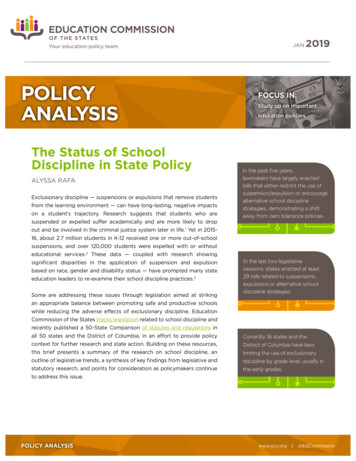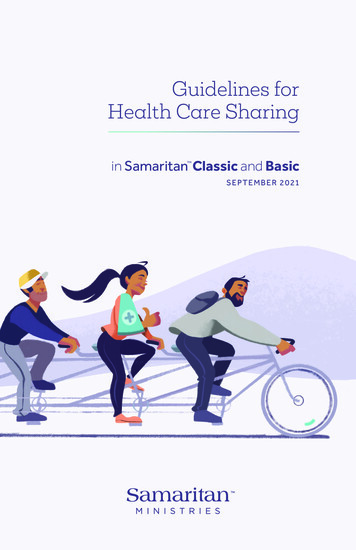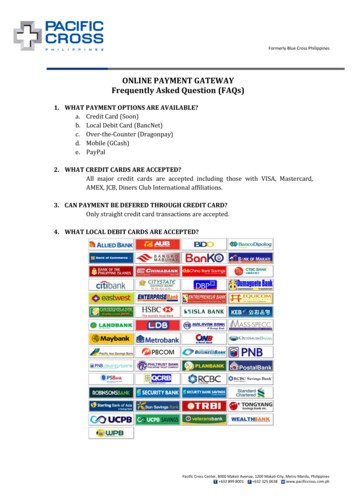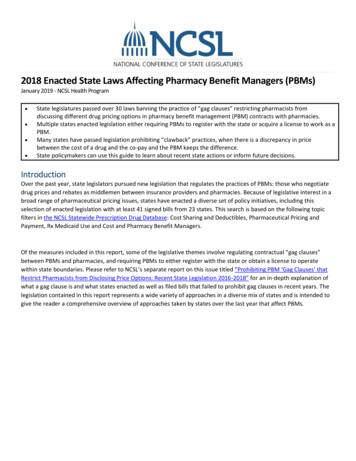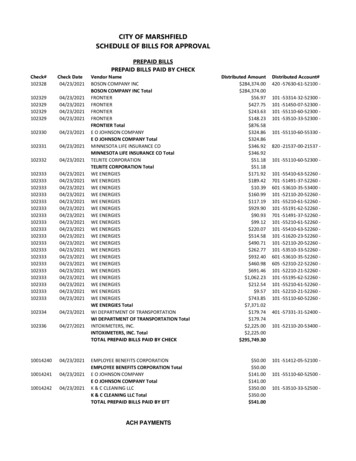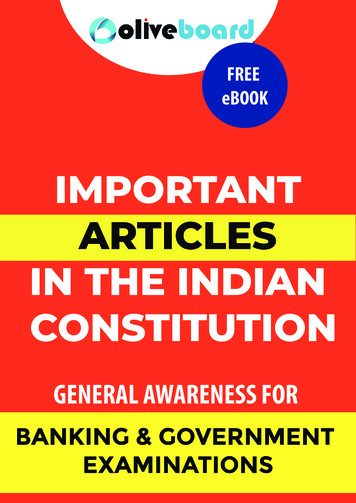
Transcription
GI Bills Enacted Prior to 2008 and RelatedVeterans’ Educational Assistance Programs:A PrimerCassandria DortchAnalyst in Education PolicyOctober 6, 2017Congressional Research Service7-5700www.crs.govR42785
GI Bills Enacted Prior to 2008 and Related Veterans’ Educational Assistance ProgramsSummaryThe U.S. Department of Veterans Affairs (VA), previously named the Veterans Administration,has been providing veterans educational assistance (GI Bill ) benefits since 1944. The benefitshave been intended, at various times, to compensate for compulsory service, encourage voluntaryservice, avoid unemployment, provide equitable benefits to all who served, and promote militaryretention. In general, the benefits provide grant aid to eligible individuals enrolled in approvededucational and training programs. Since three of the GI Bills have overlapping eligibilityrequirements and the United States is expected to wind down involvement in active conflicts,Congress may consider phasing out one or more of the overlapping programs.This report describes the GI Bills enacted prior to 2008. Although participation in some programshas ended or is declining, the programs’ evolution and provisions inform current policy. The Post9/11 GI Bill (Title 38 U.S.C., Chapter 33), enacted in 2008, is described in CRS Report R42755,The Post-9/11 Veterans’ Educational Assistance Act of 2008 (Post-9/11 GI Bill): A Primer.This report provides a description of the eligibility requirements, eligible programs of education,benefit availability, and benefits. The report also provides some summary statistics, comparisonsbetween the programs (see Table 2), and brief discussions of related programs. Individualscurrently participate in five GI Bills enacted prior to 2008: The most popular program prior to the Post-9/11 GI Bill was the MontgomeryGI Bill-Active Duty (MGIB-AD), which provides a monthly allowanceprimarily to veterans and servicemembers who enter active duty after June 30,1985.The Montgomery GI Bill-Selected Reserve (MGIB-SR) provides a lowermonthly allowance than the MGIB-AD to reservists who enlist, re-enlist, orextend an enlistment after June 30, 1985.The Reserves Educational Assistance Program (REAP), which will discontinuepaying benefits in 2019, provides a monthly allowance that is higher than theMGIB-SR but lower than the MGIB-AD to reservists with active duty service.The program with the fewest individuals receiving benefits is the Post-VietnamEra Veterans’ Educational Assistance Program (VEAP), which provides amonthly allowance to veterans who first entered active duty service on or afterJanuary 1, 1977, and before July 1, 1985.The dependents of individuals with military service may be eligible for theSurvivors’ and Dependents’ Educational Assistance (DEA) program, whichprovides benefits to the spouse and children of servicemembers who, as a resultof service, are seriously disabled, die, or are detained.Other educational support is available to veterans using these benefits. Participants may alsorequest academic and vocational counseling before and while using their GI Bill benefits.Participants on a growing number of pilot campuses have access to the VetSuccess on Campusprogram, which provides on-campus counseling and referral services. In addition to counselingsupport, some participants may participate in the Veterans Work Study Program to receiveadditional financial assistance in exchange for work while attending school.Congressional Research Service
GI Bills Enacted Prior to 2008 and Related Veterans’ Educational Assistance ProgramsContentsIntroduction . 1History of the Programs . 2Survivors’ and Dependents’ Educational Assistance Program (DEA) . 7Eligible Individuals . 7Eligible Programs of Education, Institutions, and Establishments . 8Benefit Payments . 10Monthly Allowance . 10Special Assistance to the Educationally Disadvantaged .11Special Restorative Training .11Tutorial Assistance .11Licensing and Certification Test Fees .11National Admissions and Course Credit Tests . 12Benefit Availability and Duration . 12Montgomery GI Bill—Selected Reserve (MGIB-SR) . 12Eligible Individuals . 13Eligible Programs of Education, Institutions, and Establishments . 13Benefit Payments . 14Monthly Allowance . 14Tuition Assistance “Top-Up” Program . 15Tutorial Assistance . 15Licensing and Certification Test Fees . 15National Admissions and Course Credit Tests . 15Supplemental Assistance . 16Benefit Availability and Duration . 16Transferability to Dependents . 16Montgomery GI Bill—Active Duty (MGIB-AD) . 17Eligible Individuals . 18Eligible Programs of Education, Institutions, and Establishments . 19Benefit Payments . 19In-State Tuition and Fee Charges . 20Monthly Allowance . 20Supplemental Assistance . 21Increase for Post-Korean Conflict GI Bill-Eligible Participants. 21Buy Up Program . 21Benefit Availability and Duration . 21MGIB-AD Death Benefit . 22Transferability to Dependents . 22Reserve Educational Assistance Program (REAP) . 22Eligible Individuals . 23Eligible Programs of Education, Institutions, and Establishments . 23Benefit Payments . 23Benefit Availability and Duration . 23Transferability to Dependents . 24Post-Vietnam Era Veterans Educational Assistance Program (VEAP) . 24Eligible Individuals . 25Congressional Research Service
GI Bills Enacted Prior to 2008 and Related Veterans’ Educational Assistance ProgramsEligible Programs of Education, Institutions, and Establishments . 26Benefit Payments . 26Benefit Availability and Duration of Use . 27Combination and Comparison of GI Bill Programs . 27Related Department of Veterans Affairs Programs . 31High Technology Pilot Program . 31Veterans Counseling . 32VetSuccess on Campus . 32Vocational Rehabilitation and Employment Program (VR&E) . 32Veterans Work Study Program . 34Participation and Cost . 35FiguresFigure 1. Total Veterans, Active-Duty Servicemembers, Reservists, and DependentsReceiving VEAP, MGIB-AD, MGIB-SR, REAP, DEA, and Post-9/11 GI Bill EducationBenefits each Year (1978-2016) . 36TablesTable 1. Chronology of Educational Assistance Programs Administered by the VA . 4Table 2. Selected Characteristics of Veterans’ Educational Assistance Programs . 27Table 3. Obligations and Participation of Selected ProgramsAdministered by the VA: FY2016 . 37Table A-1. Original GI Bill Participation . 41Table B-1. Korean Conflict GI Bill Participation . 45Table C-1. Post-Korea and Vietnam Era GI Bill Participation . 51AppendixesAppendix A. Educational Assistance Under the Original GI Bill of Rights . 38Appendix B. Korean Conflict GI Bill. 42Appendix C. Post-Korea Conflict and Vietnam Era GI Bill . 46Appendix D. Veterans and Dependents Education Loan Program . 52ContactsAuthor Contact Information . 52Congressional Research Service
GI Bills Enacted Prior to 2008 and Related Veterans’ Educational Assistance ProgramsIntroductionThis report provides a detailed description of five of the six educational assistance programs (GIBills )1 that are currently available to veterans or other eligible individuals through the U.S.Department of Veterans Affairs (VA). The GI Bills provide financial assistance while enrolled inapproved programs of education or training programs to individuals whose eligibility is based ona qualifying individual’s service in the uniformed services. The sixth program, which is the mostrecently enacted, is the Post-9/11 GI Bill (Title 38 U.S.C., Chapter 33). It is described in CRSReport R42755, The Post-9/11 Veterans’ Educational Assistance Act of 2008 (Post-9/11 GI Bill):A Primer. Congress regularly considers potential operational and benefit improvements for theseprograms and enacts legislation accordingly.Over the decades since 1944, during which the GI Bill programs have been in existence, twothemes have been emphasized. The benefits promote development of work-related skills tofacilitate entry or re-entry into the civilian workforce, and the base benefit is equitable regardlessof rank or military occupation specialty. All of the educational assistance programs administeredby the VA require some period of military service before benefits can be received. The mostsalient ongoing discussions have been related to how much eligible individuals should contributeto their education in time or money, which types of service warrant a benefit, and how liberal(i.e., valuable) the benefit should be.All of the benefit programs provide eligible persons an entitlement to educational assistance. Thisentitlement, usually 36 months, is measured in months and days. A dollar value is also associatedwith each month and day of entitlement. Educational assistance payments reduce the entitlementperiod based on the training period for which the payment was made or in proportion to the dollarvalue associated with each month and day of entitlement. In general, once the entitlement isexhausted eligible persons continue receiving educational assistance through the end of theacademic term if more than halfway through, or for up to a 12-week period if not on an academicterm schedule. The entitlement period is not reduced if an individual is called to active duty andif, as a result, the individual must discontinue studies and fails to receive credit or training time.2Entitlement is restored for an incomplete course or program for which the individual is unable to receive credit or lost training time as aresult of an educational institution closing;for a course or program if a necessary course is disapproved by a subsequentlyestablished or modified policy, regulation, or law; andfor the interim (through the end of the academic term but no more than 120days) housing allowance paid following either a closure or disapproval.31GI Bill is a registered trademark of the United States Department of Veterans Affairs (VA).Active duty under the following authorities qualifies: 10 U.S.C §§12301(a), 12301(d), 12301(g), 12302, 12304,12304a and 12304b. Section 416 of the Jeff Miller and Richard Blumenthal Veterans Health Care and BenefitsImprovement Act of 2016 (P.L. 114-315) amended the MGIB-SR to expand its list of qualifying authorities to include10 U.S.C §§12304a and 12304b.3This provision enacted by the Harry W. Colmery Veterans Educational Assistance Act of 2017 (P.L. 115-48) appliesto closures and disapprovals occurring after January 1, 2015, except that the amount of entitlement restored for closuresand disapprovals occurring from January 1, 2015, through August 16, 2017, is the entire period of the individual’senrollment in the closed or disapproved program. The restoration of entitlement goes into effect November 14, 2017.Eligibility for interim housing allowance payments begins August 16, 2017, and they are payable effective August 1,(continued.)2Congressional Research Service1
GI Bills Enacted Prior to 2008 and Related Veterans’ Educational Assistance ProgramsThis report describes the five GI Bills enacted prior to 2008 and related veterans’ educationalassistance programs. It is organized into five sections. The first section provides an explanation ofthe rationale and impetus behind veterans’ educational assistance programs. The second sectiondescribes the eligibility requirements and benefits of the GI Bills. The GI Bills are discussed indescending order based on the number of current participants. The third section reviews thelinkages and commonalities between the programs. A summary of selected characteristics of thevarious programs is presented in Table 2. The fourth section provides a brief overview of relatedVA programs. The final section provides information on participation and expenditures for theprograms. A detailed look at earlier GI Bills that are no longer available to participants and thelessons learned is available in the appendices.History of the ProgramsSince the Revolutionary War, the United States has provided benefits to injured or disabled warveterans; however for much of this period, benefits were not provided to the same extent to ablebodied veterans. Prior to World War II (WWII), “poor, jobless, and disgruntled veterans hadled to unrest and fear of revolt throughout American history.” In 1932, after World War I, themilitary was called in to forcibly remove 20,000 still unemployed and often homeless veteransand burn their encampment near the Capitol and White House.4In early U.S. history, military service was thought of as “a fundamental obligation of [male]citizenship.”5 Because the 16.1 million personnel6 who served in the U.S. Armed Forces7 duringWWII accounted for over one-third of the 41.1 million8 working-age males (between 20 and 64years of age) in 1947, the consequences of mass unemployment were feared. Before the end ofWWII, Congress and the American Legion9 worked together to pass the original GI Bill, orServiceman’s Readjustment Act of 1944 (P.L. 78-346).10 The act provided a full range ofresources to veterans including the construction of additional hospitals; educational assistance tonon-disabled veterans; home, business, and farm loans; job counseling and employmentplacement services; and an unemployment benefit.The original GI Bill was generally considered successful in averting unemployment, raising theeducational level and thus the productivity of the U.S. workforce, and confirming the value that(.continued)2018.4Edward Humes, “The Greatest Generation: The Accidental Remaking of America,” in Over Here: How the G.I. BillTransformed the American Dream, 1st ed. (Orlando, FL: Harcourt, Inc., 2006), pp. 4-20.5Suzanne Mettler, Soldiers to Citizens: The G.I. Bill and the Making of the Greatest Generation (New York: OxfordUniversity Press, 2005), p. 26.6Facts for Features, U.S. Census Bureau, April 29, 2004, fse07.pdf.7The Armed Forces are the Army, Navy, Air Force, Marine Corps, and Coast Guard of the United States.8U.S. Census Bureau, Table 1. Years of School Completed by Persons 14 Years Old and Over, by Age, Color, andSex, for the United States: Civilian Population, April 1947, and Total Population, April 1940.9The American Legion was chartered by Congress in 1919 as a patriotic wartime veterans organization devoted tomutual helpfulness. It is a not-for-profit community-service organization.10Suzanne Mettler, Soldiers to Citizens: The G.I. Bill and the Making of the Greatest Generation (New York: OxfordUniversity Press, 2005), pp. 18-22.Congressional Research Service2
GI Bills Enacted Prior to 2008 and Related Veterans’ Educational Assistance ProgramsAmericans place on those that provide military service.11 Subsequent GI Bills providingeducational assistance have been passed (Table 1).1211U.S. Congress, House Committee on Veterans’ Affairs, Readjustment Benefits: General Survey and Appraisal, AReport on Veterans’ Benefits in the United States, committee print, prepared by The President’s Commission onVeterans’ Pensions, 84th Cong., 2nd sess., September 11, 1956, House Committee Print No. 289 (Washington: GPO,1956), pp. 107-142.12This table includes legislation enacted through 2015.Congressional Research Service3
Table 1. Chronology of Educational Assistance Programs Administered by the VAYearEnacted1944Common NameEstablishing LegislationOriginal GI BillaCurrentlyPaying BenefitsServiceman’s Readjustment Act of 1944Title 38, Chapter 12NoVeterans’ Readjustment Assistance Act of 1952Title 38, Chapter 33(repealed in 1966)No1952Korean Conflict GI1956DEA (Survivors’ and Dependents EducationalAssistance)bWar Orphans’ Educational Assistance Act of 1956Title 38, Chapter 35Yes1966Post-Korean Conflict and Vietnam Era GI BillaVeterans Readjustment Benefits Act of 1966Title 38, Chapter 34No1974Veterans and Dependents Education LoanProgramaVeterans’ Readjustment Assistance Act of 1974Title 38, Chapter 36(repealed in 1981)No1976VEAP (Post-Vietnam Era Veterans EducationalAssistance)bVeterans’ Education and Employment Assistance Act of1976Title 38, Chapter 32Yes1981Educational Assistance Test Program (§901)cDepartment of Defense Authorization Act, 1981Title 10, Chapter 106AYes1981Educational Assistance Pilot Program(§903)dDepartment of Defense Authorization Act, 1981Title 10 U.S.C. §2141noteNo1983Veterans’ Job Training ActeEmergency Veterans’ Job Training Act of 1983Title 29 U.S.C. §1721note (repealed in 2000)No1985MGIB-AD (Montgomery GI Bill-Active Duty)bDepartment of Defense Authorization Act, 1985Title 38, Chapter 30Yes1985MGIB-SR (Montgomery GI Bill-Selected Reserve)bDepartment of Defense Authorization Act, 1985Title 10, Chapter 1606Yes1990Refunds for Certain Service Academy GraduatesfDepartment of Veterans Affairs Nurse Pay Act of1990, §207Title 38 U.S.C. §1622noteNo1992Service Members Occupational Conversion andTraining Act of 1992 (SMOCTA)gNational Defense Authorization Act for Fiscal Year1993 (P.L. 102-484)Title 10 U.S.C. §1143noteNo2005REAP (Reserves Educational Assistance Program)bRonald W. Reagan National Defense Authorization Actfor FY2005, §527Title 10, Chapter 1607Yes2008Post-9/11 GI BillPost-9/11 Veterans Educational Assistance Act of 2008Title 38, Chapter 33YesTitle II-A of P.L. 112-56, the VOW to Hire Heroes Actof 2011Title 38 U.S.C. §4100noteNo2011BillaU.S. CodeVeterans Retraining Assistance Program(VRAP)hSource: Prepared by CRS based on a review of the legislation enacted through 2016.CRS-4
a.b.c.d.e.f.g.h.CRS-5See Appendix B for a full program description.For a program description, see the entitled report section.Section 901 of the Department of Defense Authorization Act, 1981 (P.L. 96-342) authorized the Department of Defense to test the feasibility and effectiveness torecruitment and retention of a noncontributory educational assistance program, the Educational Assistance Test Program. The program was only eligible toindividuals who enlisted or reenlisted for service on active duty after September 30, 1980, and before October 1, 1981. Certain individuals were permitted totransfer their entitlement to their spouses or children. The program is funded by DOD, but paid through the VA.Section 903 of the Department of Defense Authorization Act, 1981 (P.L. 96-342) authorized the Educational Assistance Pilot Program - Noncontributory VEAP totest the feasibility and effectiveness to recruitment and retention of offering the VEAP program without requiring a monetary contribution from servicemembers.The program was only eligible to individuals who enlisted or reenlisted in the Armed Forces after September 30, 1980, and before October 1, 1981. Certainindividuals were permitted to transfer their entitlement to their spouses or children. The program is funded by DOD, but paid through the VA.The Emergency Veterans’ Job Training Act of 1983 (P.L. 98-77) was enacted “to address the problem of severe and continuing unemployment among veterans.”Unemployed Korean Conflict and Vietnam Era veterans were eligible for up to 15 months of assistance while training for high growth, high demand, or hightechnology occupations on or after October 1, 1983, and for programs beginning before April 1, 1990. The program paid to employers offering job trainingprograms 50% of the veterans’ wages, up to 10,000.Section 207 of the Department of Veterans Affairs Nurse Pay Act of 1990 (P.L. 101-366) provided a one-year period during which eligible pre-1979 service academygraduates and Senior Reserve Officers’ Training Corps completers could make an irrevocable election to disenroll from VEAP and receive the amount ofeducational assistance benefits the individual would have received under the Post-Korean Conflict and Vietnam Era GI Bill.SMOCTA was enacted to facilitate the drawdown of the Armed Forces by providing eligible individuals not less than 6 months or more than 18 months of jobtraining in a field of employment providing a reasonable probability of stable, long-term employment. Eligible individuals were discharged on or after August 2, 1990,and were unemployed, had an occupational specialty that did not readily transfer to the civilian workforce, or were entitled to veterans’ disability compensation. Theprogram paid to employers offering job training programs 50% of the veterans’ wages, up to 12,000, and up to 500 for tools and other work-related materials.Assistance was available beginning in December 1992, and for programs beginning before October 1, 1995.VRAP was created to provide employment-related training for older unemployed veterans who were no longer eligible for the GI Bill. It provided up to 12 monthsof training benefits to unemployed veterans who were not eligible for other VA education programs and were between the ages of 35 and 60. VRAP benefits werelimited to training at community colleges or technical schools in occupations that the Department of Labor (DOL) had identified as “high demand.” Monthly benefitlevels were limited to the maximum amounts under the MGIB-AD program. VRAP was limited to 45,000 participants from July 1, 2012, to September 30, 2012, and54,000 participants from October 1, 2012, to March 31, 2014.
GI Bills Enacted Prior to 2008 and Related Veterans’ Educational Assistance ProgramsThe Korean Conflict GI Bill was enacted under the Veterans’ Readjustment Assistance Act of1952 (P.L. 82-550) and codified in Title 38, U.S.C., Chapter 33. The purpose of the program wasto prepare returning veterans to enter the workforce.In 1956, the War Orphans’ Educational Assistance Act of 1956 (P.L. 84-634) was passed toprovide educational assistance to the children of servicemembers who died as a result of injury ordisability incurred in the line of duty. This program was later expanded to include spouses andchildren of servicemembers who died, became permanently or totally disabled, were missing-inaction, were captured, or were hospitalized as a result of service.The Post-Korean Conflict and Vietnam Era GI Bill was enacted under the Veterans ReadjustmentBenefits Act of 1966 (P.L. 89-358) and codified in Title 38, U.S.C., Chapter 34. In addition toproviding benefits to veterans, it provided benefits to active duty servicemembers to encourageretention in the Armed Forces. The Veterans’ Readjustment Assistance Act of 1974 (P.L. 93-508)created a short-lived veterans and dependents education loan program to cover educational costsnot provided for under the GI Bill. It was codified in Title 38, U.S.C., Chapter 36 before beingrepealed in 1981.Beginning with the Korean Conflict GI Bill, there has been much debate on the level ofeducational assistance that should be provided to veterans and servicemembers. Some believedthat requiring individuals to make a monetary contribution in addition to their military servicewould increase their sense of responsibility and purpose. Some believed that the educationalassistance benefits were a necessary compensation for compulsory service or reimbursement forvoluntary service. Some believed that high levels of assistance promote attrition from themilitary. And some believed that the benefits are a necessary recruitment tool.Congress allowed the compulsory military draft to expire on June 30, 1973. The educationalassistance programs enacted subsequently were designed to encourage recruitment and retentionof high-quality military personnel while still providing a considerable benefit to those whochoose to leave active duty military service. Since 1973 upon initial enactment of new GI Bills,Congress has generally limited the approved programs of education to a more traditional collegeeducation. As the programs mature, other types of education and training such as apprenticeshipsand flight training are added.Currently, there are several educational assistance programs available to veterans,servicemembers, and their spouses and children. The oldest of these programs for veterans andservicemembers is the Post-Vietnam Era GI Bill, enacted in 1976. Fewer than 10 individuals arestill receiving benefits from this program, which provides educational assistance in directproportion to contributions deducted from servicemembers’ pay while on active duty.13 TheMontgomery GI Bill-Active Duty (MGIB-AD) requires most servicemembers to contribute anestablished amount, although the eventual benefits are not related to the contribution. TheMontgomery GI Bill-Selected Reserve (MGIB-SR) only provides educational assistance to thosecurrently serv
The U.S. Department of Veterans Affairs (VA), previously named the Veterans Administration, . All of the benefit programs provide eligible persons an entitlement to educational assistance. This entitlement, usually 36 months, is measured in months and days. A dollar value is also associated . The restoration of entitlement goes into effect .
